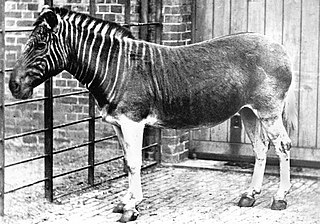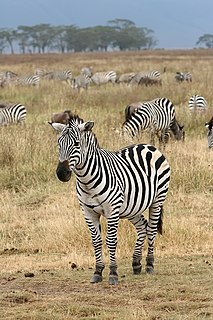Related Research Articles

Equidae is the taxonomic family of horses and related animals, including the extant horses, donkeys, and zebras, and many other species known only from fossils. All extant species are in the genus Equus, which originated in North America. Equidae belongs to the order Perissodactyla, which includes the extant tapirs and rhinoceros, and several extinct families.

The quagga is an extinct subspecies of the plains zebra that was endemic to South Africa until it was hunted to extinction in the late 19th century by European settler-colonists. It was long thought to be a distinct species, but early genetic studies have supported it being a subspecies of plains zebra. A more recent study suggested that it was the southernmost cline or ecotype of the species.

Zebras are African equines with distinctive black-and-white striped coats. There are three living species: the Grévy's zebra, plains zebra, and the mountain zebra. Zebras share the genus Equus with horses and asses, the three groups being the only living members of the family Equidae. Zebra stripes come in different patterns, unique to each individual. Several theories have been proposed for the function of these stripes, with most evidence supporting them as a deterrent for biting flies. Zebras inhabit eastern and southern Africa and can be found in a variety of habitats such as savannahs, grasslands, woodlands, shrublands, and mountainous areas.

The plains zebra, also known as the common zebra, is the most common and geographically widespread species of zebra. Its range is fragmented, but spans much of southern and eastern Africa south of the Sahara. Six or seven subspecies have been recognised, including the extinct quagga which was thought to be a separate species. More recent research supports variations in zebra populations being clines rather than subspecies.

The zebra shark is a species of carpet shark and the sole member of the family Stegostomatidae. It is found throughout the tropical Indo-Pacific, frequenting coral reefs and sandy flats to a depth of 62 m (203 ft). Adult zebra sharks are distinctive in appearance, with five longitudinal ridges on a cylindrical body, a low caudal fin comprising nearly half the total length, and usually a pattern of dark spots on a pale background. Young zebra sharks under 50–90 cm (20–35 in) long have a completely different pattern, consisting of light vertical stripes on a brown background, and lack the ridges. This species attains a length of 2.5 m (8.2 ft).

The zebra mussel is a small freshwater mussel. The species was originally native to the lakes of southern Russia and Ukraine, but has been accidentally introduced to numerous other areas and has become an invasive species in many countries worldwide. Since the 1980s, the species has invaded the Great Lakes, Hudson River, and Lake Travis.

A zebroid is the offspring of any cross between a zebra and any other equine to create a hybrid. In most cases, the sire is a zebra stallion. Offspring of a donkey sire and zebra dam are called a donkra and offspring of a horse sire and a zebra dam called a hebra do exist, but are rare and are usually sterile. Zebroids have been bred since the 19th century. Charles Darwin noted several zebra hybrids in his works.

Grévy's zebra, also known as the imperial zebra, is the largest living wild equid and the most threatened of the three species of zebra, the other two being the plains zebra and the mountain zebra. Named after Jules Grévy, it is found in Kenya and Ethiopia. Compared with other zebras, it is tall, has large ears, and its stripes are narrower.
Tragocephalini is a tribe of longhorn beetles of the subfamily Lamiinae. It was described by James Thomson in 1857.

Poimenesperus is a genus of longhorn beetles of the subfamily Lamiinae, containing the following species:
Poimenesperus holdhausi is a species of beetle in the family Cerambycidae. It was described by Stephan von Breuning in 1934.
Poimenesperus ochraceus is a species of beetle in the family Cerambycidae. It was described by Stephan von Breuning in 1934.
Poimenesperus dobraei is a species of beetle in the family Cerambycidae. It was described by Waterhouse in 1881, originally under the genus Poemenesperus.
Poimenesperus incubus is a species of beetle in the family Cerambycidae. It was described by James Thomson in 1858.
Poimenesperus laetus is a species of beetle in the family Cerambycidae. It was described by James Thomson in 1858. It is known from the Democratic Republic of the Congo, Cameroon, and Gabon.
Poimenesperus lugens is a species of beetle in the family Cerambycidae. It was described by White in 1858.
Poimenesperus nigrosignatus is a species of beetle in the family Cerambycidae. It was described by Stephan von Breuning in 1947.
Poimenesperus nigrovelutinus is a species of beetle in the family Cerambycidae. It was described by Stephan von Breuning in 1938.
Poimenesperus obliquus is a species of beetle in the family Cerambycidae. It was described by Per Olof Christopher Aurivillius in 1916. It is known from Cameroon.
Poimenesperus voluptuosus is a species of beetle in the family Cerambycidae. It was described by James Thomson in 1857. It is known from South Africa.
References
- ↑ BioLib.cz - Poimenesperus zebra. Retrieved on 8 September 2014.